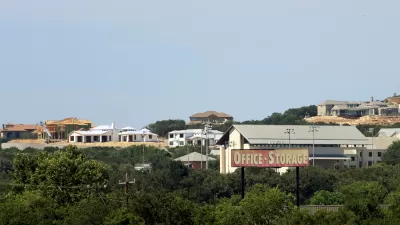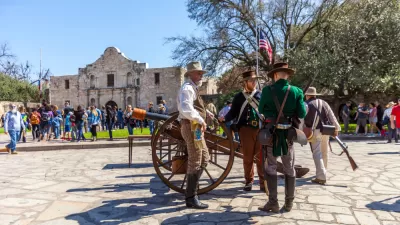San Antonio is changing, and the city's land use regulations aren't living up to the desires of the city's communities, according to one local architect and planner.

"These days, infill projects are everywhere in the collar neighborhoods [of San Antonio]," according to an article by Jim Bailey. Collar neighborhoods (i.e., "the ring of historic streetcar suburbs around downtown), like Lavaca, Dignowity Hill, and Tobin Hill are under the greatest price-point pressure, but infill is found in many other neighborhoods and could continue to spread.
According to Bailey, "[w]ith our population expected to increase by 1 million people over the next quarter-century and a renewed interest in living the good life in non-auto-dependent, economically integrated neighborhoods, these pressures will continue to mount."
While all this infill pressure is building, Bailey writes that battles between developers, neighbors, designers, and planners are getting ugly. To answer the question of why that is, Bailey proposes the following answer: "There is a disconnect between our desire for walkable traditional neighborhoods and what our development code was designed to accommodate."
The article then goes on to provide more insight into the workings of San Antonio's Unified Development Code, its 2015 Comprehensive Plan, and the overlays and exceptions in the code responsible, according to Bailey, for some of the planning and development confusion in the city's communities.
FULL STORY: Infill Development Could Make or Break San Antonio

Manufactured Crisis: Losing the Nation’s Largest Source of Unsubsidized Affordable Housing
Manufactured housing communities have long been an affordable housing option for millions of people living in the U.S., but that affordability is disappearing rapidly. How did we get here?

Americans May Be Stuck — But Why?
Americans are moving a lot less than they once did, and that is a problem. While Yoni Applebaum, in his highly-publicized article Stuck, gets the reasons badly wrong, it's still important to ask: why are we moving so much less than before?

Using Old Oil and Gas Wells for Green Energy Storage
Penn State researchers have found that repurposing abandoned oil and gas wells for geothermal-assisted compressed-air energy storage can boost efficiency, reduce environmental risks, and support clean energy and job transitions.

Minneapolis Bans Rent-Setting Software
Four cities have enacted restrictions on algorithmic software that can inflate rent costs.

Oakland to Add 244 New EV Chargers
Oakland plans to launch its new charging network at eight locations by the end of 2025.

Jane Goodall Inspires with Message of Hope, Resilience, and Environmental Action
Speaking in Pasadena, Jane Goodall offered a hopeful and inspirational message, urging global compassion, environmental responsibility, and the power of individual action to shape a better future.
Urban Design for Planners 1: Software Tools
This six-course series explores essential urban design concepts using open source software and equips planners with the tools they need to participate fully in the urban design process.
Planning for Universal Design
Learn the tools for implementing Universal Design in planning regulations.
Heyer Gruel & Associates PA
City of Moreno Valley
Institute for Housing and Urban Development Studies (IHS)
City of Grandview
Harvard GSD Executive Education
Salt Lake City
NYU Wagner Graduate School of Public Service
City of Cambridge, Maryland





























